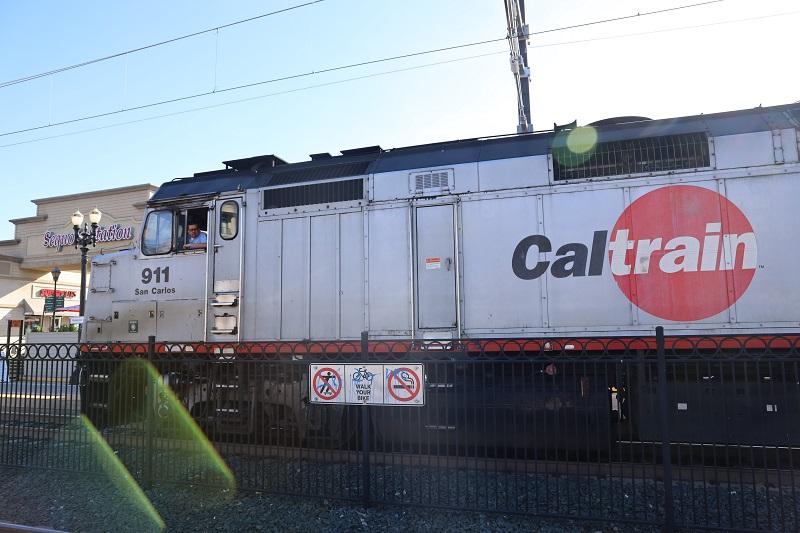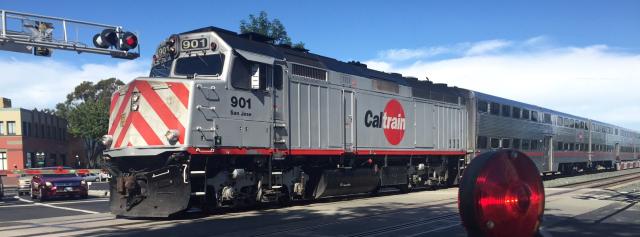The engineer applied the throttle, the engine began to roar and then, very gently, the old F40 locomotive began to move south from San Francisco. To the left of the cab was one of Caltrain’s brand new electric trains; the fresh red and white paint and modern body of the new electric train seemed to be impatient, like a hot new comic waiting for the old opener to get off stage. Or maybe it’s me that is impatient. As Caltrain’s social media lead for the last ten years, I’ve been waiting for them, for the relief they promise to passengers and our team, both strapped with the problems of an aged-out fleet.
But today was about the workhorse of American passenger rail, the F40. Up in the cab of locomotive 911, named San Carlos and running the 708 southbound express, we eased out of the 4th and King yard onto the mainline toward San Jose. I peered over the F40’s trademark snub-nose which gives these locomotives their distinctive pit bull look. The Caltrain right-of-way stretched out ahead leading us south. Gently swaying from side to side, the old engine felt soft on the rails, like a classic Chevy. As we cleared the yard the engineer throttled up a little more and we pushed toward the tunnels.
The darkness of the tunnel is countered by the proverbial light at the end, which these F40s must surely see now – their time is nearly over. Silver threads reach from the tunnel opening toward the locomotive beckoning it to emerge into the daylight on the other side. My ears pressurized in the tunnel; above us the catenary for the new electric trains hung from the tunnel ceiling. Then we burst back into the warm spring air, following weeks of rain and overcast skies.
The engineer opened up the throttle and the 911 got louder, the horn blending seamlessly with the engine’s thunderous roar, a symphony of railroad sounds as we picked up speed. The old Bayshore Roundhouse passed by on the right, another relic of the Bay Area’s rail legacy.
The stations passed by far below the elevated cab, most of them empty. Although it’s loud in the cab, there is also a peacefulness; a meditative rhythm sends one’s mind off to other places. The engineer said it can be very peaceful, but also boring. The 911 rocked and swayed as the trainset rose up on the grade separation at San Bruno Station, the Millbrae Transit Center, our first stop appeared, and the engineer let off the throttle. Down on the platform people hurried along, to or from the gallery car doors. Many would glance up into the cab, engineer was one of those jobs people were a little envious of.

I stood in the cab, staring at the tracks ahead, enjoying the gentle sway, watching the trees roll by. I knew, like many things in life, this trip would soon be over. We pulled into San Jose Diridon on time and without incident. I climbed down from the cab, asked the engineer for a photo, to which he replied, “I don’t do photos.”
Fair enough.
Today you can see an F40 in Amtrak livery at the California State Train Museum, retired many years ago and now enshrined in one of the West’s great train museums. The F40 began rolling out in 1975 and quickly began to replace older models in the Amtrak fleet and other passenger rail systems. Made by the Electro-Motive Division of General Motors, the engines became known for their rugged durability and longevity.
Caltrain has been running the F40s since 1985, that’s almost 40 years. The locomotives were purchased by Caltrans as part of their brief foray into regional rail, according to former Caltrain head of rail Chuck Harvey. The railroad was soon transferred to the JPB and rebranded as the local service we have now. The F40s were eventually joined in the fleet by the newer MP36 locomotives for the initial Baby Bullet service. This year, the electric trains will replace all the F40s, which will be sent for dismantling.
The F40s served Caltrain well and I know many of us here will miss them, as loud and cantankerous as they could be at times. For me, as a passenger and an employee, their familiar growl will be a sound I keep in my heart. As the new fleet comes into service, don’t forget to give one of the F40s a nod and thank them for their miles of service.
Jeremy Lipps, March 13, 2024.
